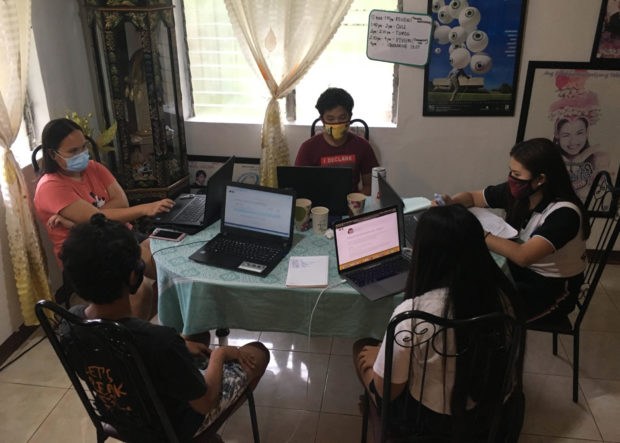UPLB study shows Filipino students’ struggle amid shift to online learning

SCHOOL AT HOME A group of students from the University of the Philippines in the Visayas (UPV) turns the house of a UPV alumnus in Pandan, Antique, into a virtual classroom. —PHOTO COURTESY OF ARDEN ROD CONDEZ
MANILA, Philippines — A recent study found that many Filipino students are still struggling in terms of learner control amid a shift to online learning due to the pandemic.
According to a University of the Philippines Los Baños (UPLB) study published on the Philippine Journal Science website in June this year, Filipino students are ready in terms of demonstrating proper computer and internet skills. However, they are not ready in terms of learner control, the Department of Science and Technology said in a statement Wednesday.
The study, entitled “Assessment of Filipino Higher Education Students’ Readiness for e-Learning During a Pandemic: A Rasch Technique Application,” was conducted by a team of researchers from UPLB’s Institute of Statistics.
https://www.facebook.com/DOSTph/photos/a.1140768235945693/4237412542947898/
Learner control of students amid pandemic
The study defined the term “learner control” as the student’s control over his or her efforts in directing his or her own learning. It also means that learners can make their own decision considering the sequence, pace, flow, and amount of instruction.
The research revealed that in terms of the learner control dimension, students found that repeating online instructional materials based on their need was the easiest to agree with. Meanwhile, not getting distracted by other online activities while learning online was regarded as one of the challenges that they faced.
“It is important to emphasize that there are students with responsibility in their own family. How would they be able to balance their responsibility from home and from academics?” one of the participants in the study said.
The focus of the research was investigating the e-learning readiness of Filipino students in higher education amid the pandemic using the five dimensions such as computer or internet self-efficacy, self-directed learning, learner control, motivation for learning, and online communication self-efficacy.
The research was conducted in 2020 and the participants included 290 students from UPLB, 80 percent of whom are undergraduate students while 20 percent graduate students.
E-learning readiness of males vs females
The study, meanwhile, revealed that gender has a significant impact on the e-learning readiness of the students.
It found that male students feel that they are less likely to repeat online instructional materials based on their needs. Meanwhile, females are more comfortable to seek help from other people when needed.
The findings also showed that graduate students or the “digital natives” have more confidence in gathering information online compared to undergraduate students. However, undergraduate students are more confident in terms of managing e-learning platforms.
Dip in numbers
The study also pointed out that due to a shift to online classes, there was a decrease in student enrollment in 2020 by 3 million from 27.7 million in both private and public schools. The dip in numbers was due to the lack of resources and preparedness for the new set-up.
The study also emphasized the vital role of teachers in achieving learning goals. They recommended that students must be given a well-detailed schedule of activities for the entire semester to manage their time wisely. Teachers are also highly encouraged to find interesting ways for students to learn such as using videos, podcasts, and other resources.
The research also found out that 97 percent of the UPLB students that participated in the study used tablets and smartphones, 89 percent have desktops and laptops and only 58 percent have a fairly reliable internet connection. — Sofia Vertucio, trainee